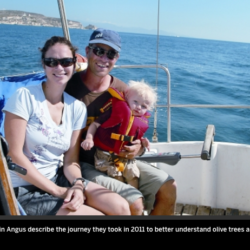I inhaled deeply, savoring the smell of roasted garlic, browned lamb, and exotic spices that perfumed my aunt Noura and uncle Nabi’s apartment in Aleppo. Their faux-wood coffee table with its skinny aluminum legs struggled under the weight of pomegranate-infused lamb stew; chicken baked in a creamy yogurt sauce; salad topped with fried triangles of pita bread; bowls of steaming lentil soup; and platters of cigarlike rolls of meat and rice tightly wrapped in vine leaves, stuffed baby eggplant, and torpedo-shaped patties of fried bulgur and ground beef known as kibbeh. This feast was to celebrate our arrival, my first trip to Syria in twenty-five years, and my husband Colin’s introduction to my extended Arab family. Pushing aside feelings of guilt about the extravagance of our meal, I heaped food onto my plate and ate unabashedly. All of it was delicious, but one item stood above the rest, not for its complexity or the effort required to prepare it but for its simplicity and purity. It was a food that I had eaten all my life but that had never evoked such a response. It was fresh and clean, like summer grass, and made my mouth tingle. It was olive oil.
I dipped a pita wedge into a faded blue bowl brimming with olive oil, or zeit, as my Arab family called it, and coated it in za’atar, a finely ground mix of roasted sesame seeds, sumac, thyme, oregano, and marjoram. The taste and smell took me back to childhood breakfasts, when my father made heaping bowls of foul—fava beans, tomatoes, and parsley in lemon juice and olive oil—while I nibbled on zeit o za’atar.
“Mmmm. This is delicious,” I said, pointing to the oil.
My aunt’s plump face spread into a wide smile, deepening the creases around her brown eyes. “It is our oil. We pressed it this year”—as they did every autumn. Between forkfuls of tomato and parsley salad gleaming with olive oil, Noura told me that they had grown olives for generations on their farm on the outskirts of Aleppo, near the Turkish border, where their hundreds of trees grew among endless olive groves that stretched all the way south to the border with Jordan. Most of Syria’s 100 million olive trees grow here, producing a tenth of the world’s olive oil and making Syria the fifth-largest olive oil–producing country in the world.
I drizzled oil onto my lentil soup, lamb stew, and baked chicken. Everything contained olive oil already, but my family also used it as a condiment, and I followed suit. It seemed to make everything taste better, bring out new and more intense flavors, add richness, and enhance the texture. How could such a simple ingredient that I’d eaten my whole life impart such a complex flavor? Why was the oil here so different from what I was used to? I was hooked. Like a whiskey aficionado who had just discovered single malt Scotch or a chocolate addict sampling his or her first truffle, I had tasted something divine and unforgettable.
I had visited Syria once before, when I was eleven. Then, my main interests were eating my aunt’s honey-drenched baklavas and playing hide-and-seek with my cousins. This time, however, I wanted to learn about my family’s lives and piece together my history. A first-generation Canadian with a Syrian father, I had no extended family in Canada, and my only window into Middle Eastern culture came through the media, often a one-dimensional portrayal, particularly after September 11.
I had come to Syria to understand the cultural undercurrents of my childhood and their influence on me, and as I listened to my family’s stories, I realized that the olive was a fundamental part of that history. My relatives had been growing olive trees for hundreds of years, and the fruit’s rhythms and cycles guided their lives—what they ate, whom they married, and how much money they made. The olive tree was at the core of who they were. It wasn’t just a commodity, as corn in Iowa might be, but was regarded in an almost spiritual way, like a talisman passed through a family for generations. The bounty of these trees was something to be cherished and shared, and the trees were nurtured so that they would continue to provide for their descendants.
The pride my family felt toward the olive was palpable. According to Kurdish lore, Afrin, the region where my family cultivated olives, was the birthplace of the domesticated olive, planted some 20,000 years ago, after one Zoroastrian clan presented olive trees and branches to another as a peace offering for taking and marrying a woman from their clan, an act banned during an era that only allowed intra-clan marriages. In the nearby archaeological site of Ebla, scientists discovered 4,400-year-old clay tablets describing olive oil, the oldest written evidence of olive oil. Other archaeological evidence suggests that the first olive trees were grown here, some 6,000 years ago, when communities were just beginning to form in the cradle of civilization. The olive is as much a part of the landscape as the minds and spirits of the people living in the regions in which it flourishes. My family considers the olive tree sacred, as do many Muslims, who are well aware of the olive’s revered role in the Koran. The three great monotheistic religions are united by their respect for the olive tree, and the Bible and the Torah also praise it as a symbol of peace and a tool for healing. I was beginning to understand that an olive is so much more than a green orb at the bottom of a martini glass.
My family’s excitement about the olive ignited my curiosity. I wanted to understand the origins and history of the fruit that meant so much to them and, in many respects, had subtly helped shape my character. And so, like an olive pit cast on dry, rocky earth, an idea was sown that, against all odds, would thrive, and three years later I would return to try to understand the mystery and meaning surrounding the fruit that had shaped humankind and continued to do so—the world’s most influential and seductive fruit.
***
Back home, my interest in the olive tree continued to grow. I’d always enjoyed olives and olive oil, but I had never given them much thought. Olives were something I had on pizza or in salads, and olive oil was just another oil in the cupboard. Sure, I knew olive oil was supposed to be good for you, but I didn’t know that it should enhance and complement food like a fine wine. Now I began to understand that my indiscriminate approach was robbing me not only of olive oil’s taste but also of its healthful properties.
I learned that corruption is rampant within the industry and that as much as half the extra virgin olive oil on supermarket shelves doesn’t meet international standards or is outright fraudulent. Although studies have found that olive oil improves cardiovascular health, prevents certain types of cancer, and helps slow Alzheimer’s disease, we aren’t getting these benefits if our “extra virgin” olive oil has been diluted with hazelnut oil or worse. Not only is this oil not good for us, but in some cases it can make us sick. Perhaps the worst example of this occurred in the early 1980s, when adulterated olive oil sold in Spain killed almost a thousand people and sickened twenty-five thousand.
As I researched the olive tree, I learned that in many ways olive oil was the original oil, highly valued, fought over, and prized for a myriad of uses. It was once worth its weight in silver, and cutting down an olive tree was punishable by death. To the great civilizations of the Mediterranean—the Egyptians, Phoenicians, Greeks, and Romans—olive oil was one of the most important commodities. Olive oil lubricated machinery, made soaps, tanned hides, and provided a base for perfumes. It fueled lamps, oiled athletes, and anointed the pious, the newly born, and the deceased. During war, it was thrown from castle walls to deep-fry attackers and brought along to nourish armies and seafarers. The Punic Wars were fought over olive oil trading routes, and Greece’s capital is named Athens because the Greek goddess Athena gave Greece the olive tree. For thousands of years, when people said oil, they meant olive oil.
Olive oil and olives have been worshipped and have played a significant cultural role for millennia. Homer called olive oil liquid gold, and Oedipus was told to offer olive branches to purify his sins. A dove brought Noah an olive leaf to signify the end of the flood, and Prophet Mohammed said olive oil cured seventy diseases. King Tutankhamen was buried with olive branches in his tomb. The original Olympic athletes were slathered with olive oil before exercising, and afterward the remaining oil, along with sweat and dirt, was scraped off their bodies and sold to aspiring athletes. Olive branch wreaths crowned the winners, and they took home thousands of liters of oil in prizes.
North Americans consume more olive oil than ever, twice as much as a decade ago, and Europeans use even more, with Greeks topping the list at some twenty-six liters a year per person. That’s like drinking a wine glass of olive oil every other day. Yet despite the olive’s popularity, or perhaps because of it, myths, untruths, and mysteries surround it. Where did people first grow olive trees? Was it the olive or its oil that was first eaten? Does olive oil really prevent cancer, Parkinson’s, and stroke? What do “virgin,” “extra virgin,” and “pure” mean, and how can we be sure we’re getting what we pay for?
To find the answers to these questions, I needed to taste olive oils, touch olive trees, and meet the people whose lives are intertwined with this tree. My home on Vancouver Island wasn’t exactly a hotbed of olive oil production; our rainy springs, overcast days, and frosty temperatures are a little too unappealing to the heat-loving Olea. I needed to travel somewhere warmer and drier, to the places where the olive tree was born and most of the trees now grow: the Mediterranean. There I could meet olive farmers, tasters, government regulators, agronomists, archaeologists, plant scientists, and retailers, and see endless varieties of olive trees, all shapes and sizes.
As I began to plan for the journey, I realized that we still didn’t know the answer to the most basic question about the olive—how did it originate? Was the olive tree originally domesticated in the Middle East? And if so, how did it spread to the rest of the Mediterranean? It was one of the olive’s greatest mysteries, albeit one many were struggling to unravel. Some believe that the olive tree was simultaneously domesticated in many areas throughout the Mediterranean; others insist that it was first domesticated in the Middle East and that those trees were spread through the Mediterranean by trade and human migration.
Because domestication occurred many millennia ago, there is little archaeological evidence to guide us. But scientists have other tools at their disposal, and a new approach that offered promising insight was genetic testing. As a molecular biologist, I knew that examining dna can allow us to understand events that happened thousands, even millions, of years ago, and I wondered what we could learn by studying the dna of ancient olive trees. I brought this idea to my publisher, National Geographic, several granting agencies, and one of the leading olive tree scientists. The response was enthusiastic, and slowly I began to put together the funding and expertise to make this project a reality.
My project was based on the question that if the olive tree was taken from the Middle East and planted on distant shores, who did this and how could we prove they did it? Given that domesticated olive trees have been growing on the opposite side of the Mediterranean, in Spain, for more than two millennia, someone must have bridged that formidable gap, and only maritime traders could travel those distances in 500 bc. Few groups had the ability to voyage great distances, and the most far-ranging early sea merchants were the Phoenicians, who made their living trading over long distances and who lived in what is now Syria, Lebanon, and Israel, the region that most likely gave rise to the domesticated olive. They set up trading posts and colonies throughout the Mediterranean, in Spain, Portugal, France, Italy, and Africa, trading in olive oil, wine, ostrich eggs, and silver. Could they have also carried olive pits or even seedlings in their boats and planted them on foreign shores?
To find out, I wanted to retrace their trading routes, stopping in the places where they traded and at the colonies they founded and searching for olive trees that bore their mark—a genetic signature linking them to ancient Phoenicia. Because of the olive tree’s long lifespan, often reaching a thousand years or even three times that, only one or two generations would separate the trees we’d find from those that grew during the Bronze Age. There was even the possibility that we’d find an olive tree planted by Phoenicians.
As I expected, it was not hard to persuade my husband, Colin, to go on another adventure.
“We can sail, just like the Phoenicians,” Colin said. “That will be the best way to follow their trading routes. It’ll allow us to anchor in the same harbors they sheltered in and stop in places that might only be accessible by water.”
It was true that sailing would allow us to better understand Phoenician voyages and the challenges the mariners faced, as well as enable us to explore the places where they might have planted olive trees. But I wasn’t convinced it was the best way to travel.
Colin sensed my hesitation. “Plus, it’ll be a fantastic way to travel with Leif,” he added.
I looked down at my bulging belly. Leif would be ten months old when we planned to leave, and although I didn’t have any experience with infants, I had read enough books to know that parenthood was challenging. We had our worries, but in the end we decided that living on a boat might even be better for a baby than being on solid ground. After all, how different was the gentle swaying of a boat to a cradle? And didn’t traditional societies throughout the world successfully raise their children in far more nomadic circumstances?
Over the next year, we planned and plotted and convinced ourselves it was the perfect idea. I had never sailed before, and we knew very little about conditions on the Mediterranean, but I reasoned that this could all be learned. We would start near the western perimeter of Old World olive groves and voyage east toward the origins of the olive tree. We would buy a sailboat at the start of our journey and sell it wherever we finished. I liked the idea of ending the journey in Syria, returning to my family’s olive farm, the place that seeded the idea for this journey, but we would have to wait and see where the olive and its secrets took us.
The rest of the logistics and planning were also falling into place. I was able to finance most of the project through a book advance from my publisher, Greystone Books, and various granting agencies. National Geographic awarded me an expedition grant, and three other organizations awarded me literary and research grants. Even the genetic analysis would be possible, and an Italian university agreed to collaborate with me and conduct DNA analysis on ancient olive trees I sampled. Finally, we were ready to begin our journey, more than two years after a meal changed my life, propelling me and my young family on an adventure that would take us to some of the most ancient and fascinating parts of the world.

























